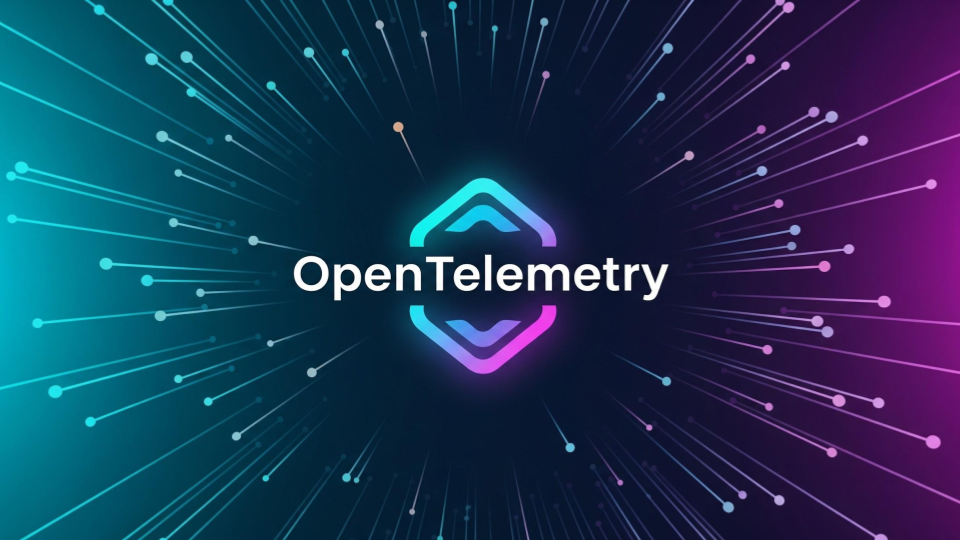How OpenTelemetry is standardizing DevOps observability

OpenTelemetry (OTel) is an open-source observability framework that provides a standardized way to generate, collect, process, and export telemetry data – including metrics, logs, and traces.
Think of it as a universal language and toolkit for your observability needs. It's a project under the Cloud Native Computing Foundation (CNCF), the same folks behind Kubernetes.
How OpenTelemetry works
In observability what we essentially do is:
1. Extract data (metrics, logs, traces) from different parts of our systems
2. Record the data
3. Analyze/correlate the data to derive insights
For the observability tools to extract, we must expose data from our software systems in a protocol compatible with the respective observability tools.
This is known as instrumenting.
OpenTelemetry provides a set of SDKs to instrument your software so that you can send telemetry data to multiple observability tools.
Why OpenTelemetry Matters (The Problem It Solves) 😫
Before OpenTelemetry, the observability landscape was fragmented and often frustrating:
- Vendor Lock-in: Each observability vendor typically had its own proprietary agents and SDKs. Once you instrumented your application with a specific vendor's tools, migrating to another vendor became a significant undertaking, often requiring a complete re-instrumentation.
- Inconsistent Data Formats: Different tools produced telemetry data in varying formats, making it challenging to correlate information across systems and gain a holistic view.
- High Overhead: Running multiple vendor-specific agents on your infrastructure could consume significant resources.
- Limited Interoperability: Integrating data from different observability solutions was often complex and cumbersome.
OpenTelemetry solves these problems by:
- Providing a single, vendor-agnostic standard for instrumentation.
- Ensuring consistent data formats across all telemetry signals.
- Offering a single agent/collector for handling all your telemetry data, reducing overhead.
- Facilitating seamless integration with various open-source and commercial observability backends.
In short, OpenTelemetry empowers you with flexibility, control, and efficiency in your observability strategy.
Open source observability tools ❤️ OpenTelemetry
The open-source community has enthusiastically embraced OpenTelemetry, with many popular tools offering robust support:
- Prometheus: A leading open-source monitoring system, Prometheus can scrape metrics exposed by the OpenTelemetry Collector in the Prometheus exposition format. Newer versions are also experimenting with native OTLP ingestion, making the integration even smoother.
- Grafana: The ubiquitous observability dashboarding tool can readily visualize metrics and traces collected via OpenTelemetry and stored in various backends like Prometheus, Loki (for logs), and Tempo (for traces). Grafana supports OpenTelemetry data sources, allowing you to build unified dashboards.
- Loki: Grafana's open-source log aggregation system can receive logs from the OpenTelemetry Collector. This allows you to centralize and query your application logs alongside metrics and traces.
- Tempo: Grafana's open-source distributed tracing backend is designed to work seamlessly with OpenTelemetry. It efficiently stores and queries traces collected via OTel.
- Jaeger & Zipkin: While OpenTelemetry aims to unify tracing, it maintains compatibility with these established open-source tracing systems. You can often configure the OpenTelemetry Collector to export traces in Jaeger or Zipkin formats.
This strong open-source support underscores the community's belief in OpenTelemetry as the future of observability.
Commercial observability tools embrace OpenTelemetry 🤝
Commercial observability vendors also recognize the importance of OpenTelemetry and are actively integrating it into their platforms:
- Full Support for OTLP: Most major vendors now offer native support for the OpenTelemetry Protocol (OTLP), the standard wire format for transmitting telemetry data. This means you can directly send data from your OpenTelemetry-instrumented applications (via the Collector or SDKs) to their backends.
- Simplified Ingestion: They are streamlining the process of getting OpenTelemetry data into their platforms, often providing dedicated endpoints and configurations for OTLP.
- Enhanced Features: Commercial vendors are leveraging OpenTelemetry data to power their advanced features, such as AI-driven insights, root cause analysis, and service maps.
- Active Contributions: Many commercial observability companies are actively contributing to the OpenTelemetry project itself, demonstrating their commitment to its success.
By supporting OpenTelemetry, commercial vendors are providing their users with greater flexibility and future-proofing their observability investments. You're no longer locked into a single vendor's instrumentation.
Best practices for OpenTelemetry 👍
To make the most of OpenTelemetry, consider these best practices:
- Start Early: Begin instrumenting your applications with OpenTelemetry as early in the development lifecycle as possible.
- Embrace Semantic Conventions: Follow OpenTelemetry's semantic conventions for naming attributes and metrics. This ensures consistency and facilitates better correlation and analysis across different systems.
- Use the OpenTelemetry Collector: Leverage the power and flexibility of the OpenTelemetry Collector for data processing, filtering, batching, and exporting to multiple backends.
- Configure Exporters Wisely: Choose the appropriate exporters in the Collector based on your target observability backends.
- Focus on Meaningful Telemetry: Instrument your applications to collect data that provides genuine insights into their performance and behavior. Avoid collecting excessive or irrelevant data.
- Keep SDKs and Collector Updated: Regularly update your OpenTelemetry SDKs and Collector to benefit from the latest features, bug fixes, and performance improvements.
- Educate Your Team: Ensure your development and operations teams understand the principles and benefits of OpenTelemetry.
- Contribute to the Community: Get involved in the OpenTelemetry community by contributing code, documentation, or feedback.
OpenTelemetry is more than just another observability tool.
It's a foundational shift towards a standardized and vendor-agnostic approach of building observability in DevOps.
But, OpenTelemetry is still quite new. You'll find many software teams still using proprietary SDKs for instrumenting their software.
Whether OpenTelemetry will be the de facto; we do not know yet.
Some OpenTelemetry SDKs are still in beta/development stage. If you are looking for open-source projects to contribute this could be a good opportunity and its experience would come in handy at your next job interview.

